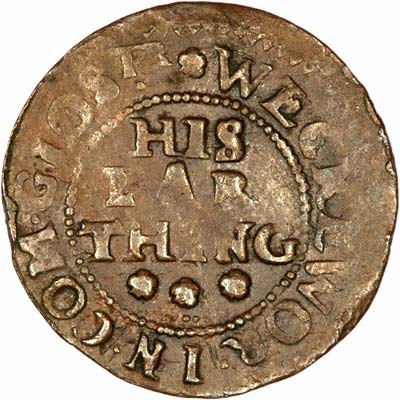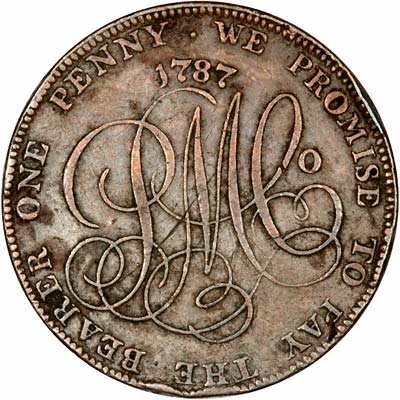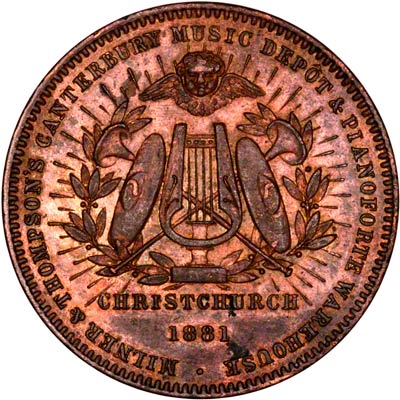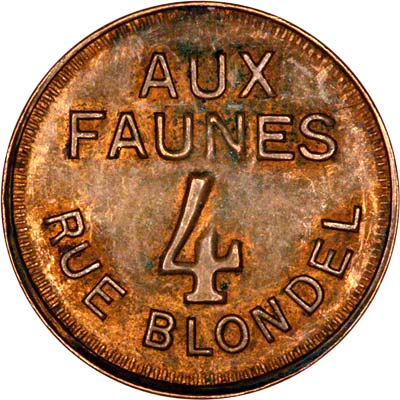| The Very Highest Quality Tokens... |
| A History of World Tokens |
|

|
|
|

|
|
|
|
|

|
|
|
|
|

|
|
|
|
|

|
|
|
Lead Tokens
Lead tokens became popular during the 13th century as a means of providing small change. Often issued by the church, they were not officially sanctioned issues, but were widely accepted for small transactions. Rulers in Europe tended to view striking conveniently sized base metal issues as beneath their royal dignity, and were reluctant to supply this demand themselves, the issue of lead tokens carried on into the reign of Elizabeth I.
Harrington Farthings, and the First Merchant Tokens
During the reigns of James I and Charles I of England, the Royal Government licenced the production of small change to private manufacturers in return for a hefty licence fee, although these farthings were unpopular with merchants because their issuers refused to redeem them for their equivalent face value in silver or gold coin. They were suppressed during the Commonwealth Period, although the need for small change remained.
First Merchant Token issues
This time, the merchants themselves decided that the best way to resolve the problem by issuing their own tokens, which were often redeemable at the issuer's place of business for goods or services provided by the merchant. As a bonus, they acted as a form of advertising for those who issued the tokens, a factor which was not lost on future generations of merchants and other businessmen.
However, the varying quality and loss of seignourage (profit made on striking coins) by allowing these tokens to circulate encouraged Charles II to initiate a reform that would see the Royal Mint issuing farthings and halfpennies struck in base metal (tin and copper) for the first time. Throughout the 17th and early 18th centuries, a plentiful supply of farthings and halfpennies was produced and the token issues were suppressed and disappeared from circulation.
'Conder' Tokens
By the reign of George III, a shortage of small change was developing once again. The industrial revolution had led to an explosion in the demand for coinage, but the government was unable and unwilling to supply this demand. Part of the problem was that the decrepit state of the Royal Mint's machinery had made it more and more difficult to strike copper coins profitably, another was that almost as soon as new coins appeared, they disappeared into the forger's furnace, where they were melted down and recast into lightweight counterfeits. The production of hand milled regal farthings and halfpennies ceased after 1775, and the shortfall was made up for in counterfeits, which were estimated to account for over half of the currency in circulation in Britain at the time.
Once again, it was the merchants who decided to take matters into their own hands by issuing their own currency. In 1786, the Parys Copper Mining Company in Wales had a double problem, it had a mass of surplus copper and was finding it difficult to find coins suitable for paying its workers, thanks for the tendency of coins (even counterfeit ones) to flow away from the countryside and into the cities. The Mining Company solved this problem by striking penny and later halfpenny tokens from its surplus stock of copper, and other businesses soon followed suit. Many of these tokens were struck by the Soho Manufactory in Birmingham by Messrs Matthew Boulton and James Watt.
In contrast to the merchants tokens of the previous century, these tokens, struck using modern steam powered methods, were usually of higher quality than the official regal issues, and in addition to advertising the merchant's business, were also used to espouse the views of the issuing party, often with a radical or conservative political message. The issuing of similar merchant tokens was also commonplace in the American colonies, where a coin shortage even more severe than that in the mother country. Struck and used both before, during and after the American War of Independence, 'Liberty' and 'Freedom' were popular themes represented on these American tokens, and were, ironically, often struck by Matthew Boulton, who was a convinced Tory who had taken a fiercely pro-Crown stance during the lead up to and during the hostilities in the American Colonies.
The issuing of 'Conder' Tokens (so named for James Conder, an Ipswich Draper who collected and catalogued these tokens in addition to issuing his own). Continued throughout the Napoleonic Wars and continued until the 1816 Coinage Reform Act.
Later Tokens
In Australia and New Zealand, a shortage of currency continued into Victorian times, long after the problem had resolved itself in Britain. Merchants once again issued their own tokens in silver and copper, such as the Hogarth and Erichson & Co of Sydney Threepenny, and the Milner and Thompson's 'Advance New Zealand' penny tokens, advertising their music shop in Christchurch, New Zealand.
Even in comparatively modern times, tokens have been used as an alternative currency in places were super or hyperinflation has rendered official currency almost worthless. Telephone tokens (good for one phone call) where often used as money in Italy during periods of high inflation.
Today, most tokens are used primarily for promotional purposes, designed to provide a novelty for consumers (and to encourage people to spend money on their premises). Although considered exonumisma, tokens have played an important role in the history of money, and offer a fascinating avenue of research and collection for any numismatist to consider.
Coins & tokens Wanted
We make an active market in almost all world coins and tokens. If you have any of these coins to sell, please contact us, or post them to us for appraisal and offer.
| ...at the Lowest Possible Price |
|
32 - 36 Harrowside, Blackpool, Lancashire, FY4 1RJ, England. Telephone (44) - (0) 1253 - 343081 ; Fax 408058; E-mail: enquiries@24carat.co.uk The URL for our main page is: https://24carat.co.uk | Chard(1964) Ltd |